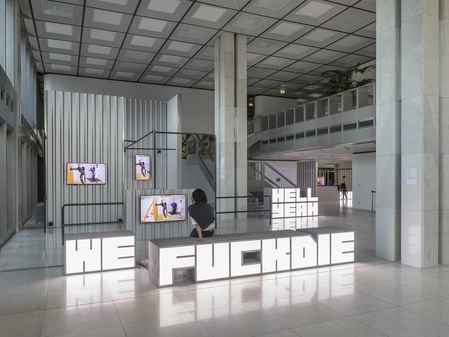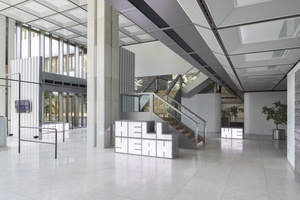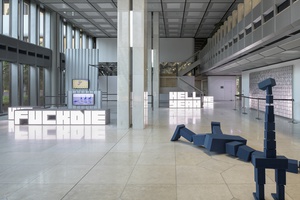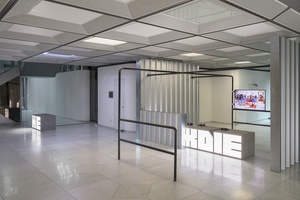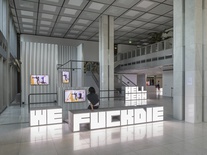Hito Steyerl
HellYeahWeFuckDie
2017
3-channel-video installation, environment, 4 min., HD video (2016)
Location
LBS West
Himmelreichallee 40
access via Promenande, Foyer A
Temporary installation for the duration of the exhibition
Credits
Original soundtrack: Kassem Mosse • Post-production: Christoph Manz, Maximilian Schmoetzer • Line producer: Lawren Joyce • Producer / Director of photography: California Robotic Challenge Kevan Jenson • Assistant: Milos Trakilović Special thanks to: Dr. Imad Elhajj (Vision & Robotics Laboratory, American University of Beirut), Siyuan Feng (The Robotics Institute, Carnegie Mellon University), Thomas Geijtenbeek, Noel Maalouf (Vision & Robotics Laboratory, American University of Beirut), Natural Motion, MIT DARPA Robotics Challenge Team, Michiel van de Panne, Frank van der Stappe, Seedwell Media, Benjamin Stephens (Robotics Challenge Team, Carnegie Mellon University), WPI-CMU DARPA Robotics Challenge Team, Zhibin (Alex) LI (University of Edinburgh School of Informatics) and ATRIAS ROBOT (Oregon State University Terrestrial Robotics Engineering & Controls Lab, Virginia Tech)
Robots Today
Material
HD video, 8 min. (2016)
Credits
Protagonists: Nevin Soyukaya (archaeologist, researcher, writer, Head of the Department Cultural Heritage and Tourism; Diyarbakır), Abdullah Yaşin, (researcher and writer; Cizre) • Dancers: Ibrahim Halil Saka, Vedat Bilir, Sezer Kılıç • Music: Kassem Mosse • Post-production: Christoph Manz, Maximilian Schmoetzer • Assistant: Milos Trakilović • Camera: Savaş Boyraz • Translation: Rojda Tugrul, Övül Durmosoğlu • Production: Misal Adnan Yıldız, Şener Özmen • Support: Bariş Şehitvan, Zelal Özmen, Sümer Kültür Merkezi Diyarbakır
Hito Steyerl
* 1966 in München, Germany, lives in Berlin, Germany
Hito Steyerl’s films, installations, and writings come out of a systemic way of thinking and working, in which artistic production and the theoretical analysis of global social issues are closely linked. Steyerl investigates the interaction and synthesis of technological and artistic imagery, for example, at the level of visual mass culture — and its function within the overall dispositif of technocracy, monetary policy, the abuse of power, and violence. Her lecture Is the Museum a Battlefield? at the 13th Istanbul Biennial (2013) took as its theme the question of how artists and the art industry are involved in this network. Martin Lockheed, the sponsor of her film about the death of her friend Andrea Wolf (November, 2004) is himself a manufacturer of guns and ammunition — and of the bullet that killed Andrea Wolf in 1998 while she was fighting for the Kurdistan Workers’ Party (PKK).
The location Steyerl chose for her installation is the Westdeutsche Landesbausparkasse (LBS savings bank) with its futuristic technocratic architectural style. It was built in 1975 at the northern end of the old zoo by the banker Ludwig Poullain. In what used to be the cashier’s hall and lobby there are kinetic works by Heinz Mack, Günther Uecker, Otto Piene, etc., from the LBS collection, which has been made accessible to the public again within the framework of Münster’s Skulptur Projekte. Steyerl installed tubular steel barriers and corrugated steel partitions in the lobby of the modernistic building. Compiled audiovisual sequences can be seen on three monitors: documentary lab footage showing computer-simulated or actual physical force applied to humanoid robots to test their balance behaviour. The videos began with the animation of a fragmented sentence: HELL YEAH WE FUCK DIE — which according to the online magazine Billboard are the most frequently used five words in the English language music charts of the past decade. They provided the basis for the musical compositions and also appear in neon lettering encased in concrete. In the smaller cashier’s room in the back there is a further installation with the same elements and an additional video: footage from south-eastern Turkey of the Kurdish town of Cizre on the Syrian border, which now resembles a ghost town following numerous skirmishes of escalating intensity between the government and the PKK. It is the native town of the Arabic writer and engineer Al-Jazari, who wrote a book about mechanical apparatuses in 1205 to convey knowledge about ingenious devices, a work known as Automata in Western culture. Steyerl combined the pictures of the town with questions addressed to SIRI, the software installed on the mobile phone: What role does computer technology play in war?
Nicola Torke
Images
Location
- Still existing / Public Collection
- Removed
- In the museum
